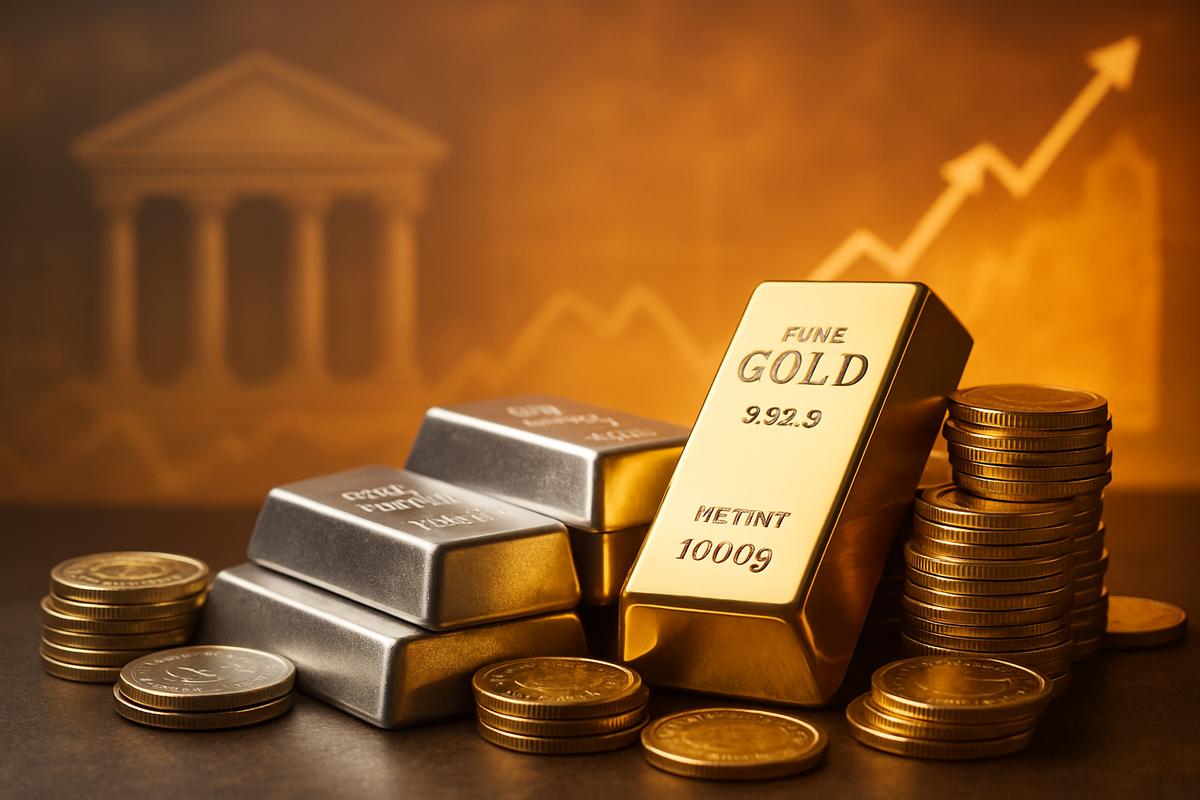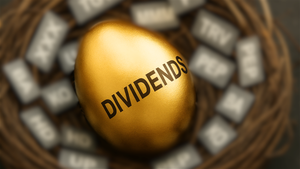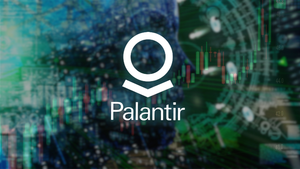
The global financial landscape as of October 1, 2025, is witnessing a remarkable surge in gold and silver prices, with both precious metals experiencing a robust bull run. This significant upward trend is largely propelled by a complex interplay of central bank policies, persistent inflation concerns, and a general climate of market uncertainty. Gold has ascended to new all-time highs, nearing $3,900 per troy ounce, while silver has not only reached a 14-year peak but has also outpaced gold in percentage gains year-to-date, trading around $47 per troy ounce. This rally signals a flight to safety and a hedge against economic instability, with profound implications for investors and the broader financial markets.
Central Bank Policies and Inflation Ignite Precious Metals
The current precious metals rally is deeply rooted in anticipatory shifts in monetary policy and the lingering shadow of inflation. Markets are heavily pricing in a near-100% probability of a 25-basis-point interest rate cut by the Federal Reserve in October 2025, with further cuts expected in December. This dovish pivot by central banks, aiming to stimulate economic activity, invariably weakens the U.S. dollar and reduces the attractiveness of yield-bearing assets like bonds. Consequently, non-yielding assets such as gold and silver become more appealing, driving investor capital into these safe havens. The expectation of lower borrowing costs makes holding precious metals, which do not offer interest, a more viable investment strategy compared to interest-bearing alternatives.
Adding to the bullish sentiment is the persistent concern over inflation, which continues to hover above the Federal Reserve's 2% target. Gold, traditionally viewed as the ultimate inflation hedge, is regaining its prominence as investors seek to protect their purchasing power against currency devaluation. The perception of low or negative real interest rates further diminishes the opportunity cost of holding precious metals. Moreover, global central banks have been consistently increasing their gold reserves, acquiring over 1,000 tonnes annually in recent years, which provides a strong underlying demand foundation for the metal. This strategic shift by central banks to diversify reserves away from fiat currencies underscores a broader lack of confidence in traditional monetary stability.
Silver's exceptional performance, with year-to-date gains exceeding 60%, is attributed to its dual role. Beyond its monetary appeal, silver is an indispensable industrial commodity. Robust demand from burgeoning sectors such sectors as solar energy, electric vehicles (EVs), and consumer electronics is creating a significant supply deficit. The Silver Institute projects a global silver market deficit, where production is anticipated to fall short of industrial and investment demand, further bolstering its price. Geopolitical tensions and domestic uncertainties, including a U.S. government shutdown that commenced on October 1, 2025, have also intensified safe-haven demand, contributing to the strong bullish momentum observed in both metals. The combination of monetary and industrial demand factors positions silver for continued strength.
Companies Poised to Win or Lose from the Precious Metals Boom
The ongoing bull run in gold and silver prices creates a distinct set of winners and losers across the financial markets, primarily impacting mining companies, precious metals funds, and industries heavily reliant on commodity inputs.
On the winning side, gold and silver mining companies are experiencing a significant boost to their profitability. Higher commodity prices directly translate into increased revenues and wider profit margins, assuming production costs remain relatively stable. Major players like Barrick Gold Corporation (NYSE: GOLD), Newmont Corporation (NYSE: NEM), and Agnico Eagle Mines Limited (NYSE: A.E.M.) are likely to see their stock prices appreciate, driven by improved earnings prospects and increased investor interest. Similarly, silver miners such as Pan American Silver Corp. (NASDAQ: P.A.A.S.) and Hecla Mining Company (NYSE: H.L.) stand to benefit immensely from silver's outperformance, especially given the strong industrial demand. These companies may also leverage higher prices to fund exploration, expand existing operations, or reduce debt, further enhancing shareholder value.
Furthermore, Exchange Traded Funds (ETFs) and mutual funds specializing in precious metals or commodity-linked investments are also clear beneficiaries. Funds like the SPDR Gold Shares (NYSEARCA: G.L.D.) and the iShares Silver Trust (NYSEARCA: S.L.V.) directly track the prices of gold and silver, respectively, providing investors with exposure to the rally without direct ownership of the physical metal. Their net asset values and investor inflows are likely to surge, reflecting the strong market sentiment. Companies offering precious metals streaming and royalty agreements, such as Franco-Nevada Corporation (NYSE: F.N.V.) and Wheaton Precious Metals Corp. (NYSE: W.P.M.), also stand to gain, as their revenue streams are directly tied to the production and price of the metals from the mines they finance.
Conversely, industries heavily reliant on gold and silver as raw materials could face challenges. Jewelry manufacturers might experience increased input costs, which could squeeze profit margins or necessitate higher retail prices, potentially impacting consumer demand. Companies in the electronics sector that use silver for its conductivity, or firms in the solar panel manufacturing industry, could see their production costs rise. While the industrial demand for silver is a key driver of its price, sustained high prices could eventually lead to a search for more cost-effective alternative materials or efficiency improvements, though this is a longer-term concern. In the short term, these businesses will need to manage higher procurement costs, which could affect their overall profitability and competitive positioning.
Broader Significance and Market Implications
The ongoing bull run in gold and silver is not an isolated event but rather a significant indicator of broader shifts within the global financial system. This rally fits squarely into a trend of increasing de-dollarization efforts by various nations and a growing distrust in fiat currencies, especially amidst persistent inflationary pressures. The aggressive purchasing of gold by central banks globally, which has doubled historical averages in recent years, underscores a strategic pivot towards tangible assets as a hedge against currency volatility and geopolitical risks. This move signals a broader acknowledgment among monetary authorities that diversification beyond traditional reserve currencies is prudent in an increasingly uncertain world.
The potential ripple effects on competitors and partners are substantial. For instance, the strength in precious metals could draw investment away from other asset classes, such as equities or bonds, particularly if real interest rates remain low or negative. This could create headwinds for sectors that thrive on easy access to capital or robust consumer spending. Furthermore, the elevated prices of gold and silver could stimulate increased exploration and production efforts by mining companies, potentially leading to new discoveries and increased supply in the long term, which could eventually temper price growth. However, given the current supply deficits, particularly for silver, any immediate increase in supply is unlikely to fully offset demand.
Regulatory and policy implications are also noteworthy. Governments and central banks might face increased pressure to address inflation more aggressively if the flight to precious metals signals a loss of confidence in their monetary policies. There could be calls for greater transparency in central bank gold holdings or discussions around the role of precious metals in the international monetary system. Historically, periods of significant precious metals rallies often coincide with economic instability, high inflation, or geopolitical turmoil. The current scenario bears resemblance to the late 1970s and early 2000s, when inflation and geopolitical uncertainties drove similar surges. These historical precedents suggest that the current bull run could persist as long as the underlying macroeconomic factors remain unresolved, reinforcing the role of gold and silver as ultimate safe havens.
What Comes Next: Navigating the Precious Metals Landscape
Looking ahead, the trajectory of gold and silver prices will largely hinge on the evolution of central bank policies, the persistence of inflation, and the geopolitical landscape. In the short term, the anticipated Federal Reserve interest rate cuts in October and December 2025 are expected to provide continued tailwinds for both metals. Any further dovish signals or unexpected economic slowdowns that prompt additional monetary easing could fuel further rallies. However, the market should also be prepared for potential short-term volatility, especially if economic data deviates significantly from expectations or if there are sudden shifts in geopolitical tensions. Technical indicators for gold suggest it might be entering overbought conditions, hinting at a possible consolidation or pullback before resuming its upward trend.
In the long term, the structural drivers for gold and silver appear robust. Persistent inflation, even if it moderates slightly, is likely to keep real interest rates low, maintaining the appeal of precious metals as inflation hedges. The increasing industrial demand for silver, particularly from the green energy transition (solar panels, EVs), is a powerful secular trend that is unlikely to abate soon. This fundamental demand, coupled with potential supply deficits, positions silver for sustained growth. For gold, its role as a global reserve asset and a safe haven against geopolitical instability will continue to underpin its value. Strategic pivots for investors might include increasing exposure to physical metals, precious metals ETFs, or well-managed mining companies that demonstrate strong operational efficiency and growth prospects.
Potential market opportunities may emerge in specific segments of the mining industry, such as companies with strong exploration pipelines or those focused on silver production. Challenges could include increased regulatory scrutiny on mining practices or potential supply chain disruptions affecting production. Scenarios range from a continued, steady ascent for both metals if macroeconomic conditions remain supportive, to periods of consolidation or even temporary pullbacks if central banks surprise with hawkish shifts or if inflation unexpectedly cools rapidly. Investors should closely monitor central bank communications, inflation reports, and global geopolitical developments to adapt their strategies. The current environment presents both significant opportunities for growth and the need for careful risk management in the precious metals space.
Wrap-Up: A Resilient Future for Precious Metals
The current bull run in gold and silver prices represents a confluence of powerful macroeconomic forces, underscoring the enduring role of these precious metals as hedges against inflation and safe havens during times of uncertainty. Key takeaways include the significant impact of anticipated central bank interest rate cuts, which diminish the appeal of yield-bearing assets, and the persistent concerns over inflation, which drive investors towards assets that protect purchasing power. Silver's remarkable outperformance highlights its dual utility as both a monetary asset and a critical industrial commodity, with strong demand from green technologies providing a robust foundation for its price appreciation.
Moving forward, the market for gold and silver is expected to remain resilient, supported by these fundamental drivers. While short-term volatility is always a possibility, particularly around economic data releases or central bank announcements, the overarching trend appears bullish. The strategic accumulation of gold by central banks globally further solidifies its position as a foundational asset in the international financial system. This trend suggests a broader re-evaluation of currency risk and a shift towards tangible wealth preservation.
For investors, the coming months will require vigilance. Monitoring the Federal Reserve's interest rate decisions, global inflation data, and geopolitical developments will be crucial. The performance of mining companies and precious metals-backed ETFs will continue to reflect the broader market sentiment. This period marks a significant chapter in financial history, reaffirming the timeless appeal of gold and silver as essential components of a diversified investment portfolio, offering a beacon of stability in an increasingly unpredictable world.
This content is intended for informational purposes only and is not financial advice.






